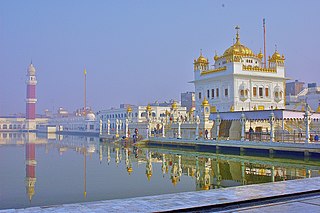
Gurdwara Sri Tarn Taran Sahib is a Gurdwara established by the fifth Guru, Guru Arjan Dev, in the city of Tarn Taran Sahib, Punjab, India. The site has the distinction of having the largest sarovar of all the Gurdwaras. It is famous for the monthly gathering of pilgrims on the day of Amavas. It is near Harmandir Sahib, Amritsar.

Tarn Taran Sahib is a city in the Majha region of the state of Punjab, in northern India. It is the district headquarters and hosts the municipal council of Tarn Taran district. Gurdwara Sri Tarn Taran Sahib, a prominent Sikh shrine is located in the central part of the city.

Doaba also known as Bist Doab, is the region of Punjab, India that lies between the Beas River and the Sutlej River. People of this region are given the demonym "Doabia". The dialect of Punjabi spoken in Doaba is called "Doabi". The term "Doaba" or "Doab" is derived from Persian "دو آب" meaning "land of two rivers". The river Sutlej separates Doaba from the Malwa region to its south and the river Beas separates Doaba from the Majha region to its north.

Majha is a region located in the central parts of the historical Punjab region split between India and Pakistan. It extends north from the right banks of the river Beas, and reaches as far north as the river Jhelum. People of the Majha region are given the demonym "Mājhī". Most inhabitants of the region speak the Majhi dialect, which is the basis of the standard register of the Punjabi language. The most populous city in the area is Lahore on the Pakistani side, and Amritsar on the Indian side of the border.

Kartar Singh Sarabha was an Punjabi Sikh revolutionary. He was 15-years-old when he became a member of Ghadar Party; he then became a leading luminary member and started fighting for the Indian independence movement. He was one of the most active members of the movement. In November 1915 at Lahore, he was executed for his role in the movement when he was 19 years old.
Malwa is a region of India in the south-east of the state of Punjab and parts of Haryana and Rajasthan, between the Sutlej and Yamuna rivers.

Balachaur is a town in Balachaur Tehsil in the Shaheed Bhagat Singh Nagar District of Punjab, India.

Sirhind-Fategarh is a city and a municipal council in the Fatehgarh Sahib district in the Indian state of Punjab.

Sunam Udham Singh Wala is a city and a tehsil in Sangrur district in the Indian state of Punjab. The city of SunamUdham Singh Wala, which falls in Sunam Udham Singh Wala tehsil, was previously known as Sunam, Punjab Government renamed after the Indian freedom fighter and martyr Shaheed Udham Singh in 2006

Giddarbaha, is a town and a municipal council in Muktsar district, in the Indian state of Punjab.

Nangal Khurd is a small village in the Hoshiarpur district of Punjab, India. Kalan is a Persian language word which means big and Khurd is a Persian word which means small; when two villages have the same name they are distinguished with the appropriate term together with the village's name. The total area of the village is 15 square kilometres and the population is around 1300. Nangal Khurd is situated 4 km from Mahilpur on Mahilpur-Phagwara Road (Via-Pasta).

Palahi is an historical village in Kapurthala, Punjab, India. Palahi is near Phagwara. Neighbouring villages include Khurampur, Khatti, Barn, Kishanpur, Nangal Maja and Dhak Palahi.

Muggowal or Mugowal is an agricultural village in the Hoshiarpur District of Punjab in India. It is birthplace of the founder of Ad-Dharm movement and Bahujan activist Babu Mangu Ram Mugowalia.

Naura is a town in the Shahid Bhagat Singh Nagar district of Punjab, India. It is located about 2 km from Khatkar Kalan, the home town of Shaheed Bhagat Singh, on the Banga - Gharshanker road. Jawaharlal Nehru, first Prime Minister of India visited Naura attending agricultural trade show along with his daughter Indira Gandhi. The town is nicknamed across many Punjabi villages as: "Naura Bhaura".
Talwandi Kalan is a village of Sidhwan Bet Mandal. Talwandi Kalan is in Jagraon, Ludhiana district, Punjab, India.Khurd and Kalan Persian language word which means small and Big respectively when two villages have same name then it is distinguished as Kalan means Big and Khurd means Small with Village Name. This village is about 10 km from Mullanpur Dakha and is nearby the villages Swaddi Kalan and Gureh. The exact cartographic location of Talwandi Kalan is (30.853849,75.592875).

Lakhpur is a village near Sahni (Lakhpur-Sahni), Tehsil Phagwara, Kapurthala district, in Punjab, India.

Kiratpur also known as Kiratpur Sahib is a town in Rupnagar district, Punjab, India. The town is the location of the Gurdwara Patal Puri where Sikhs take ashes of their deceased.

Dhandwar is a village or Pind, which comes under Jalandhar district, Tehsil Phillaur, Punjab, India. It is near Dosanjh Kalan and Apra. Dhandwar is a very old village. The surname Dhandwar is 2 familes made this village. As per the voter list of September 2018 around 1150 people are above 18 age live in the village. The village contains a collaboration of all religions and they all living together happily with maintained peace. Dhandwar is also known as Dhandwara is well.

Chabhal Kalan in Gurmukhi ਝਬਾਲ ਕਲਾਂ is a village in the Tarn Taran district of Punjab, India and is located 13 miles away from Amritsar city.
Nangal is a small village near Nihal Singh Wala Tehsil in the Moga district of Punjab, India. This small village had a population of nearly 2500 according to the 2011 census.








